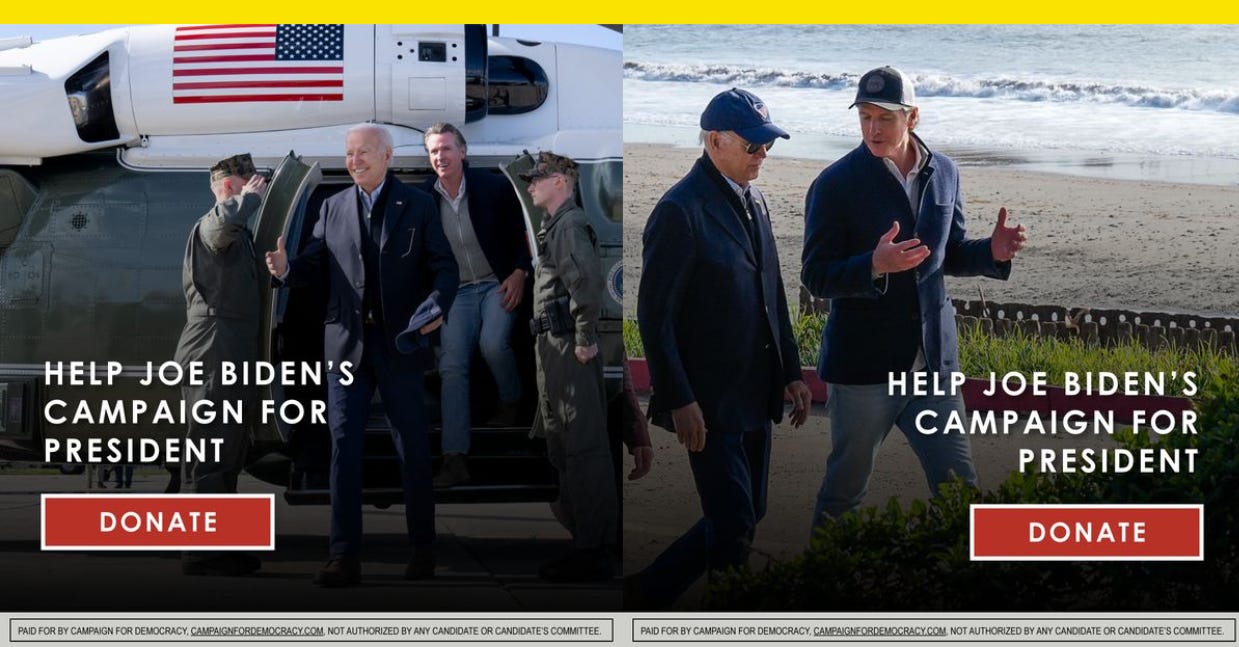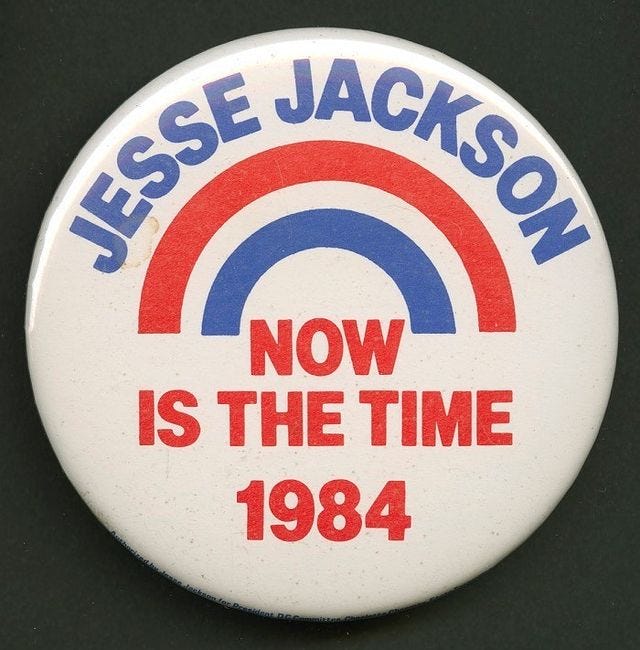To actually make persuasive political ads, this study found campaigns should experiment
Plus: Gavin Newsom keeps advertising out-of-state. Now he faces a recall threat.
Hello, in this issue we’ll look at…
To actually make persuasive political ads, this study found campaigns should experiment
Gavin Newsom keeps advertising out-of-state. Now he faces a recall threat.
A coalition of hospital CEOs are funding a public awareness campaign to reduce gun violence
Scroll to the end to see: which Star Wars robot head is heading to auction.
To actually make persuasive political ads, this study found campaigns should experiment
What makes a political ad effective? Are positive campaign ads better than negative ones? Should ads be more or less pushy?
According to new research, the answer to all of these questions is a somewhat unsatisfying “it depends.” Using data from Swayable, researchers tested reactions to 617 political ads produced by 51 Democratic campaigns between 2018 and 2020, and they found that context really does matter.
“The unifying theme of the results is inconsistency,” authors wrote in the study, published this month in the American Political Science Review. Their findings have the potential to blow up years of research that’s guided political campaign advertising best practices.
Political ads tend to be reactionary. Whether a candidate chooses to highlight their experience or draw attention to their work on a popular issue often comes down to the opposition’s messaging. At the same time, the interests and desires of their constituents are constantly changing. A message that was persuasive four years ago might not resonate the same way today.
“Despite the large body of theoretical work predicting consistent patterns in what kinds of messages work to persuade voters, there are good reasons to expect that no such general patterns exist,” authors wrote. “Voters’ views and priorities shift over time, and persuasive messaging in real campaigns.”
In 2018, for example, ads that focused on the issues were highly effective for congressional candidates (that year, healthcare was mentioned in more ads for U.S. House and Senate candidates than any other issue, according to the Wesleyan Media Project). But issues-based ads weren’t as effective with voters in 2020. That year, ads with a female “messenger,” or ads that were more “pushy” were effective in the presidential race, but not for down-ballot races. And ads that included candidate facts were good for congressional candidates in both 2018 and 2020, but not in the presidential race.
The implication of these findings is that there is a lot more room for political candidates to experiment and that multivariate testing could give campaigns an important edge. That benefits campaigns with bigger budgets to pay to overproduce ads and test them, and because better-performing ads do such a better job at persuasion than an average ad, campaigns that run tested ads get a better bang for their buck, further compounding the benefit.
The study found an especially effective ad can be twice as persuasive as the average ad, and wealthier campaigns are able to spend $50 per vote less than small campaigns because of their investments in experimentation to find what messages best convert. The advantage to running an A/B-tested ad strategy is so great that researchers say an optimal campaign would devote 10% or more of its media budget to ad experimentation.
This represents “a whole new category of expenditure that scarcely figures in classic theories of campaigning,” researchers say, with implications for democracy and the role of money in politics.
Gavin Newsom keeps advertising out-of-state. Now he faces a recall threat.

A day after California Gov. Gavin Newsom’s political action committee announced its latest ad, a 30-second spot attacking a so-called “abortion trafficking” bill being considered in Tennessee, a conservative group called Rescue California launched a new effort to remove him from office.
Arguing Newsom “abandoned the state to advance his presidential ambitions,” campaign director Anne Dunsmore told Politico, “California needs a full-time governor who is fully focused on the serious problems the state and its citizens are facing.” The group now must collect some 1.38 million signatures by May to make it onto the ballot.
Newsom handily defeated a 2021 recall effort, and afterwards poured millions in leftover donations into Campaign for Democracy, a PAC. Campaign for Democracy has come to be known for its out-of-state ads promoting blue state values in red states, like a 30-second spot criticizing Florida’s abortion policies under Gov. Ron DeSantis and billboards in Texas saying the state doesn’t own women’s bodies.
Campaign for Democracy has helped elevate Newsom’s profile far outside Sacramento and given him a platform to boost President Joe Biden. In December and January, the PAC ran digital ads with images of Newsom looking the part of Biden’s running mate (above) that sought donations to split with Biden’s campaign.
Its new spot “Hostage” hits a Tennessee bill that would criminalize helping pregnant minors get an abortion without parental consent. The ad shows a young girl handcuffed to a hospital bed next to a table with a box labeled “sexual assault evidence collection kit.”
“Trump Republicans want to criminalize young women who travel to receive the reproductive care that they need,” says the narrator. “Don’t let them hold Tennessee women hostage.” It’s a dramatic ad Newsom says speaks to the stakes of red-state abortion policy, and he’s using it to raise money for the Democratic Party of Tennessee.
At home, though, a significant share of voters wish Newsom would stay focused on California. A Berkeley IGS poll released last November found 45% of California registered voters support Newsom taking on a more prominent role in national Democratic politics compared to 43% who are opposed.
A coalition of hospital CEOs are funding a public awareness campaign to reduce gun violence
Firearm injuries kill more young people in America than any other cause of death, and now a group of executives at some of the largest health systems and hospitals in the U.S. are funding a campaign to try and stem the tide.
The Ad Council announced Tuesday that members of the National Health Care CEO Council on Gun Violence Prevention and Safety had donated $10 million for a campaign focused on how gun violence affects young people. The initiative is seeking an additional $40 million over two years
The Ad Council says it has “large-scale plans” for the campaign, which will shift “away from divisive, politically charged conversations to those focused on public health approaches.”
“American hospitals deal with the ramifications of gun violence every day and we’re proud to partner with our nation’s leading hospitals and health systems, public health experts and some of the best minds in the media and advertising communities to educate individuals on actions that can be taken to reduce the risk of gun violence and make our children, communities and nation safer,” Ad Council president and CEO Lisa Sherman said in a statement.
GUT Miami, a creative agency that has counted clients including Google, Michelob Ultra, and WeightWatchers, will provide pro-bono work for the campaign, the Ad Council said.
Have you seen this?
Nikki Haley launching major ad buy, signaling she’s staying in through Super Tuesday. Acknowledging the race is an uphill climb, Nikki Haley's campaign said it will be launching a "seven-figure" national cable and digital ad buy. [NPR]
This coveted Star Wars prop could fetch $1 million at auction. British actor Anthony Daniels is parting ways with the iconic golden helmet he wore portraying the character C-3PO on the set of Star Wars: Return of the Jedi (1983). [Artnet News]
Keith Haring almost landed a dream deal with Disney, according to new biography. The offer from Walt Disney Studios came just days before the artist's death in 1990. “The focus would be Mickey Mouse as seen through the eyes of Keith Haring.” [Artnet News]
History of political design
Jesse Jackson “Now is the Time” button (1984). Jackson said during his 1984 campaign that he was uniting a “rainbow coalition” of voters, a concept that extended to rainbow graphics in campaign items like this button.
Thanks for reading! Like what you see? Subscribe for more:
A portion of this newsletter was first published in Fast Company.









